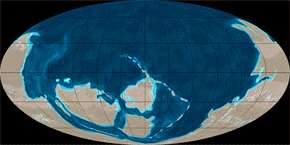Deep Time
Perissodactyls first appeared about 55.8 MYA (million years ago). This seems like a very long time. Anatomically modern humans (Homo sapiens) have only existed for about 200,000 years. Therefore, perissodactyls have been around about 275 times as long as our species and over 9,000 times the span of recorded human history!
However, in comparison to the age of the earth and the duration of life on this planet, perissodactyls are newcomers. Geologists estimate the earth to be 4.54 billion years old. On this basis, complex animal life has only existed for about 10% of earth's history, and perissodactyls have only been present for the last 1%. As you can see, the earth is very old!
That final 10%, which is called the Phanerozoic Eon, spans 545 million years. It is subdivided into three periods, known as “eras:” the Paleozoic (“old life”), the Mesozoic (“middle life”) and Cenozoic (“new life”). In this website, we will mostly be looking at events that occurred in the Cenozoic era.
Mammals first appeared during the Mesozoic, around 200 MYA, but for much of the era the dominant land animals were the dinosaurs. Mesozoic mammals tend to be smaller and much less common than those of today; the largest known Mesozoic mammal, Repenomanus from the Cretaceous of China, reached maybe a meter in length.
Following a major extinction event at the end of the Mesozoic 65 MYA (the most probable cause of which was a huge meteor impact) the only group of dinosaurs to survive were the ancestors of today’s birds. By contrast, there were many types of mammal that survived the mass extinction. Among these were the ancestors of the modern mammal fauna. The Cenozoic was, and is, the age of mammals.
The fossil record of the Cenozoic is very extensive and paleontologists have been able to piece together a very detailed history for life of this time period. It is divided into seven epochs. Much has changed over the past 65 million years and each of these epochs is very different in terms of the species (perissodactyls and other species) that were present, the configuration of the continents, and global climate. We will explore these factors in greater detail in the “Evolution” and “Environment” sections of this website
Click on the names in the sidebar for a summary of the main features of each Epoch.

